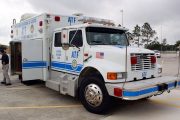
On Monday a group representing about 7,000 drone manufacturers and operators from government organizations, industry, and academia released an industry-wide code of conduct to allay fears of privacy violations.
According to the press release issued by the Association for Unmanned Vehicle Systems International, describes the code as “a set of guidelines to provide AUVSI members — and those who design, test and operate UAS for public and civil use — with recommendations for their safe, non-intrusive operation.”
“We understand as an industry that we’ve got a public relations problem,” Paul McDuffee, a director of the association who helped write the code told the Associated Press.
A public relations problem is a mild — and perhaps callous — way of describing the problem with the proliferation of drones. As readers are aware, the use of these drones has become a popular political issue among constitutionalists and other friends of liberty.
Furthermore, in recent weeks the use of the drones to hunt and kill suspected terrorists believed to be hiding in the mountainous region of the Pakistan-Afghanistan border has caused tension in the relationship between the United States and Pakistan — its erstwhile ally in the “War on Terror.”
It seems that not a day passes without reports of “militants” being killed by remote control. Drones patrol Pakistan using high-powered optics to find and fire on those considered enemies by the men with the joysticks.
A couple of weeks ago, for example, an American drone attack killed at least three of these suspected belligerents in northwest Pakistan, a region described by American intelligence and military officers as a “hotbed” of Taliban and al-Qaeda operatives.
And, given the preparations being made for deployment of hundreds of drones in the skies over the United States, the situation in Pakistan may be only the early symptoms of a fatal disease.
Beginning in 2006, the U.S. Customs and Border Patrol (CBP) began purchasing (as yet) unarmed Predator drones purportedly to aid in the securing of America’s southern border. According to a report written by the DHS Inspector General, as of the end of 2012, CBP will have 12 of these aircraft in its arsenal with a total cost to taxpayers of nearly $200 million.
CBP Predators have been used to conduct missions for the following federal and state government agencies:
U.S. Secret Service, Federal Emergency Management Agency (FEMA), Immigration and Customs Enforcement (ICE); Bureau of Land Management; Federal Bureau of Investigation; Department of Defense; Texas Rangers; U.S. Forest Service; and National Oceanic and Atmospheric Administration (NOAA).
It’s been about a year since a North Dakota man was arrested after a local SWAT team tracked him down using a Predator drone it borrowed from the Department of Homeland Security. Although the story has not been widely reported, Rodney Brossart became one of the first American citizens (if not the first) arrested by local law enforcement with the use of a federally owned drone aerial surveillance vehicle after holding the police at bay for over 16 hours.
Brossart’s arrest is surely the first in what will be thousands of such search and apprehend missions conducted by drones controlled by sheriffs nationwide.
For those who doubt such devious intent on the part of law enforcement, witness the story of the Houston Police Department’s glee over their recent purchase of a drone. The Houston Chronicle reports:
Chief Deputy Randy McDaniel of the sheriff’s office said the $300,000 ShadowHawk drone — purchased from Vanguard Defense Industries with federal homeland security grant funds — will take to the air in the coming months to provide another tool in the law enforcement arsenal.
“It’s an exciting piece of equipment for us,” he said. “We envision a lot of its uses primarily in the realm of public safety — looking at recovery of lost individuals and being able to utilize it for fire issues.”
In the future, the drone could be equipped to carry nonlethal weapons such as Tasers or a bean-bag gun, McDaniel said.
Taser and bean-bag guns today, Hellfire missiles and machine guns tomorrow.
Still don’t believe the warning? Read what one commentator wrote (with obvious pride) about a similar small drone — the Switchblade: “…it is an ingenious, miniature unmanned aerial vehicle (UAV) that is also a weapon.”
Do the research: Drones are cheaper than helicopters, they are more agile, they are more accurate, they are quieter, they are smaller — all of which makes them exponentially deadlier. Drones are indeed the quieter, quicker killer and they will be used to the best of those abilities.
Not everyone is afraid of the drones, however. Some states are racing to be the first to fill their skies with the hum of squadrons of drones.
Congress has tasked the Federal Aviation Administration with drafting a plan for drones to be deployed domestically by September 2015, and believe it or not, several states are competing to become one of six locations to help implement that plan.
Witness this story from USA Today:
“The skies over Florida will look dramatically different in the years to come,” Space Florida President Frank DiBello told a gathering of aerospace professionals this month.
The agency’s board recently approved spending up to $1.4 million to try to win designation as one of six test ranges across the country that Congress has directed the Federal Aviation Administration to name by the end of the year.
The FAA anticipates that about 10,000 unmanned aircraft will be patrolling over cities and towns in the United States within five years.
Fortunately, citizens concerned about the normalization of such deadly tools and tactics have begun fighting the drone deployment and their possibly illegal use in the monitoring and killing of thousands in Pakistan, Yemen, and elsewhere.
In the last year or so, the American Civil Liberties Union (ACLU) and a group of reporters have filed Freedom of Information Act (FOIA) petitions requesting that the federal government provide greater access to operational details of the drone program and the legal arguments forwarded by the Obama administration in justifying not only the use of the drones, but their use in the killing of thousands in Pakistan alone.
The ACLU’s Chris Calabrese told the Associated Press that the recently composed code of conduct for the drone industry is respectable, but does not go far enough.
“I think it’s really important that they’re paying attention to privacy. That’s to their credit. But I can’t imagine they expect this to quell privacy concerns,” he told the Associated Press.
“I think Congress needs to step in. This is new technology. It’s potentially incredibly invasive. People are profoundly discomforted by the idea of drones monitoring them,” he continued.
Maybe, maybe not.
According to a recent survey conducted by the Monmouth University Polling Institute, nearly 80 percent of respondents supported using drones for search-and-rescue missions.
Over 60 percent were in favor of drones being used to search for criminals.
Friends of liberty support the lawful efforts of state and local police to enforce the law and keep our streets safe. They are aware, however, that government begins the deprivation of freedom under the name of protecting the people, but freedom is the only currency it will accept in exchange for that safety.



